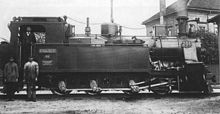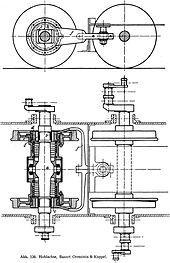Klien-Lindner hollow axle
The Klien-Lindner hollow axle is a special drive axle in steam locomotives , which, thanks to its radial adjustability, enables the vehicles to run better . It was developed by engineers Ewald Richard Klien and Heinrich Robert Lindner of the Royal Saxon State Railways .
Constructive features
A hollow shaft carrying the wheels is connected in the middle to the solid drive shaft passing through it via a cardanic ball joint. In this context, both waves are also imprecisely referred to as axes. The cardanic joint consists of a hollow ball in the hollow axle divided at this point, a spherical thickening of the solid axle sliding therein and a driving pin seated in this ball element, which is guided in the hollow axle in two axially extending scenes . The drive torque is thus transmitted from the axle mounted in the outer frame to the hollow axle of the wheel set , whereby the angle of the hollow axle can still be adjusted. When deflected from the central position, a tumbling relative movement occurs when the two axes rotate. The hollow axle is also axially displaceable due to the displaceable mounting of the intermediate element forming the hollow ball of the universal joint. In order to limit the angular adjustability to the level of the tracks , that is to say to prevent rolling movements of the locomotive , the hollow axle is usually additionally supported at its ends in horizontally extending scenes in a drawbar frame.
use
Despite the comparatively simple construction, the Klien-Lindner hollow axle has only partially proven itself in operational use. The Klien-Lindner hollow axles in particular caused the locomotives to run unevenly, which occasionally led to derailments . In addition, there was a higher maintenance effort, which was often disproportionate to the benefit of the lower wheel flange and track wear. The Klien-Lindner hollow axle was therefore mainly used in areas where only a low driving speed was required and the disadvantage of uneven running no longer played a role. It was most widespread in locomotives for narrow-gauge railways , and especially in forest and field railways .
Locomotives with Klien-Lindner hollow axles (selection):
- Saxon IK (partially)
- Saxon VK
- Saxon XV HTV
- Saxon IX V
- Prussian T 37
- BBÖ Kh
- GLÜCKAUF and TRUSETAL of the Trusebahn
- Army field railway locomotive HF 210 E
- HFB brigade locomotive
- No. 1 to 3 of the local railway Rosenberg – Korytnica (MÁVAG type 50)
- MÁVAG type 70 (k.uk. Heeresbahn IVe)
- MÁVAG type 85
Further developments
The Orenstein & Koppel locomotive factory in Berlin later improved the design considerably. The hollow axle was now supported on the core axle via an additional drawbar frame. The principle-related rolling movements were thus prevented.
See also
literature
- German imperial patent DRP 27.892 and 68.932, 1893
- Lionel Wiener : Articulated Locomotives . Constable, London 1930 (Reprint with a new introduction by RA Le Massena: Kalmbach Publishing Co., Milwaukee WI 1970).




